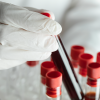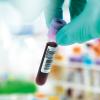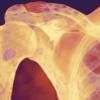Malcolm Robinson, co-founder of Harvey’s Gang, tells how allowing children into pathology labs is transforming their healthcare experiences – and those of the staff who meet them.
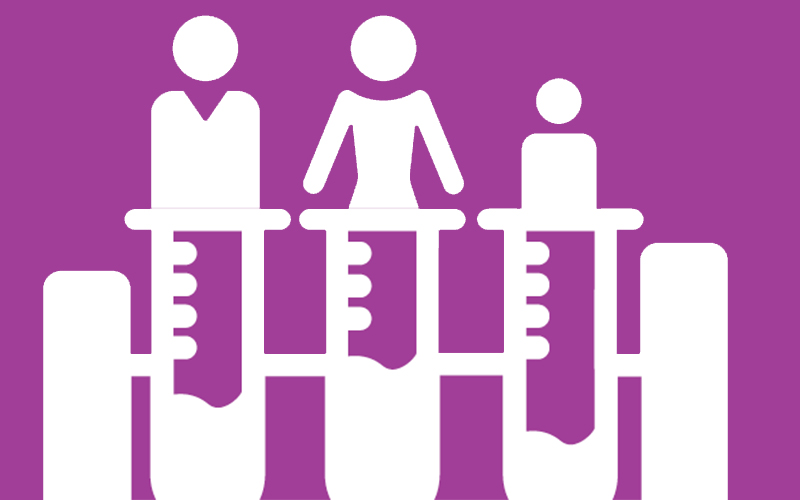
Malcolm Robinson is a man on a mission. Through his work for the charity Harvey’s Gang, he has helped more than 200 children get a behind-the-scenes laboratory tour, enabling them to understand where their blood samples go, and how they are processed.
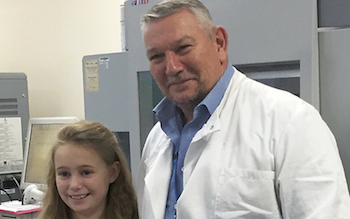
Something “so simple” he says, has not only empowered these children, answering their questions, allaying their fears and even helping some overcome needle phobias, but also improved the working lives of his colleagues, by allowing them to connect with the patients they help care for.
Having seen for himself how powerful the experience can be, he wants it to become part of the care pathway for every child. Malcolm, who is Blood Transfusion Manager at the Western Sussex Hospitals NHS Trust, says: “I have had a consultant paediatrician request a Harvey’s Gang tour as a treatment for their patient – that’s really something. That’s the ultimate goal, that’s why we’ve set up the charity – we want to be involved in improving patients’ healthcare.”
Harvey Buster Baldwin
Malcolm’s inspiration was, and is, Harvey Buster Baldwin, who passed away on 6 October 2014, aged just eight.
Harvey became ill with acute myeloid leukaemia when he was six years old, necessitating a raft of blood tests and transfusions as part of his treatment at Worthing Hospital, East Sussex.
“He wanted to know where they went, what happened to them, and who did it – he was a curious young lad,” explains Malcolm.
To answer his questions, a laboratory visit was arranged. Malcolm found him the smallest lab coat he could, which still hung down to his ankles, a goody bag, and even a cardboard ‘trainee biomedical scientist’ security pass. He gave him a tour, and showed him how to process his own blood.
Malcolm recalls Harvey sitting in front of the blood grouping machine throughout the full 33-minute process, “watching it and asking questions all the way through”.
Harvey continued his treatment and received a bone marrow transplant from his elder brother – but sadly his body rejected it. It was then a matter of palliative care.
Only after his death did Malcom truly appreciate the impact that visit had on him.
He recalls the emotional moment, when, among the special images from Harvey’s life being shown on a screen at his funeral, he saw a photo, taken on that day, of him and Harvey side-by-side in front of the machine.
“I was a complete wreck,” says Malcolm, who later learned from Harvey’s parents what the tour had meant to their son.
When a consultant paediatrician said he had seven more critically ill children who wanted a tour too, Malcolm got to work.
Harvey’s Gang
Within two weeks, Harvey’s Gang was launched. The first tour took place 11 days after Harvey’s funeral, and three years on, it is in 22 trusts, with 28 more expected to go live by the end of the year, and many more interested across the UK – and beyond.
Malcolm and his colleagues were presented with the Kate Granger 2015 Team Award for Compassionate Care, and Malcolm won the 2016 Chief Scientific Officer’s Award for Patient and Public Participation.
Harvey’s Gang was mentioned five times and praised as “exemplary” in the trust’s 2016 ‘outstanding’ CQC report.
“The positive response is just incredible,” says Malcolm. “And it’s something so simple.”
Indeed, he has made it as simple as possible for others to follow in his footsteps, producing start-up kits for new sites, complete with child-sized lab coats, certificates, goody bags, and even sample risk assessments and application forms for parents.
And he is sharing the idea as widely as possible, presenting at meetings and conferences and to individual trusts. He also still gives tours, and is chairman of trustees for the charity.
“Yes, it does take up my time, but I get so much positivity back,” says Malcolm. “When another place starts up and you see the pictures – the smiles on the children’s faces – you take pride in that.
“The children will remember you and the answers you give them for a long time,” he says. “We talk at their level – not down to them – and that empowers them. They have less questions for the doctors and nurses, because the scientists have answered them. And they come back with some questions of their own, which have the doctors perplexed, wondering ‘how does a child know all this stuff?’
“Hopefully in a generation we might have lots more biomedical scientists coming into our profession as a result.”
Making the profession better
Not only does Harvey’s Gang improve children’s experiences, but in meeting them, staff are given a boost, believes Malcolm, who now sees less sickness and stress, and improved morale and job satisfaction in those around him.
“We have all got woes,” he says. “We all know we haven’t had pay rises that are actually worth anything in quite some time, the bills are going up – life is tough. But these children have all their woes, and they come in with smiles on their faces – that really puts you in your place.
“I think Harvey’s gang has helped us to come together as a team. The team camaraderie is so much better – not just among the biomedical scientists, but the MLAs too. All the staff really go that extra mile for each other and for the patients.
“Anybody that starts doing this, and starts hearing the stories, gets so moved by it, that it builds on their compassion – it makes them a better person, a better manager. They learn to listen a bit more, to respond in a better way to their staff and colleagues and their patients.”
He adds: “It’s making our profession better. It starts breaking down the walls of the laboratories, so people realise there are humans in there doing their damndest to produce the best possible service for our patients – it’s not just about budgets and turnaround times.”
And, while he and his colleagues used to “complain bitterly” when imperfect samples came in, having “no idea of the story behind the sample or the trauma a young person may have had to go through to get it,” now they do.
“Instead of seeing blood tubes we now see people – we recognise the names, we are now giving better quality care,” he adds.
Harvey’s legacy “I think Harvey would be amazed,” says Malcolm. “His parents are trustees of the charity, and they are blown away at where this has gone in the name of their son.
“He affected me, and we have affected everybody else. It’s all come from that one very inquisitive lad singing our positive praises when he went back to the ward – that has made a huge difference, and will continue to do so.”
Alison Kydd's story
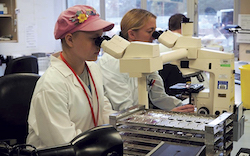

During her treatment for bone cancer, my daughter Caitlin, 13, was intrigued about what happened to the blood samples they took and how they worked out the important numbers that came back. So she was invited to tour the labs at William Harvey Hospital in Ashford.
It was very helpful to Caitlin to see the whole process completed for every blood sample, throat swabs and blood cultures that she had taken. This ‘mystery’ of what happened has now been explained, and has helped her to make sense of and understand the importance of that part of her treatment.
Caitlin has her sights set on becoming a Research Scientist so this was an invaluable experience. Just being in the labs, observing what goes on and encountering the lab environment was so beneficial for her. And she loved every minute. All the way around the tour she was itching to join in and start working.
The tour increased her appetite for science and has given her encouragement to continue to reach for her goals and look to the future, a very important mindset to have.
We are touched and humbled for Caitlin to be a member of Harvey’s Gang. It is very close to our hearts, as she shared time in hospital with Harvey.


